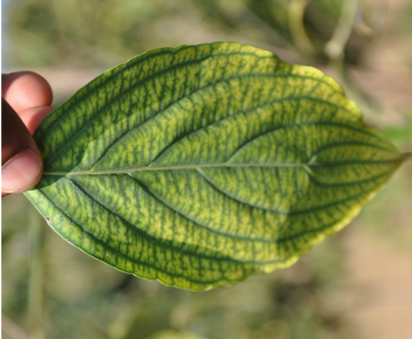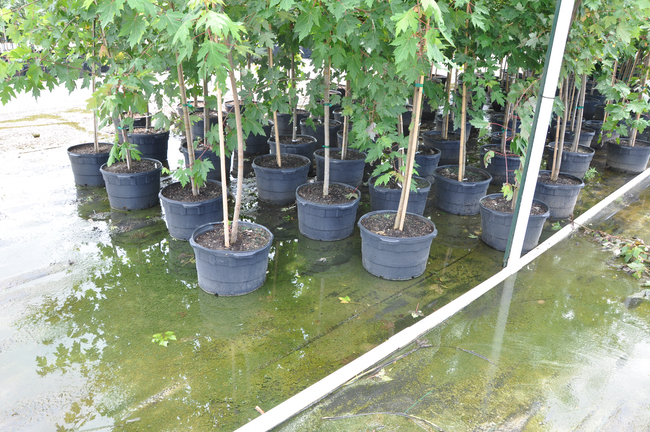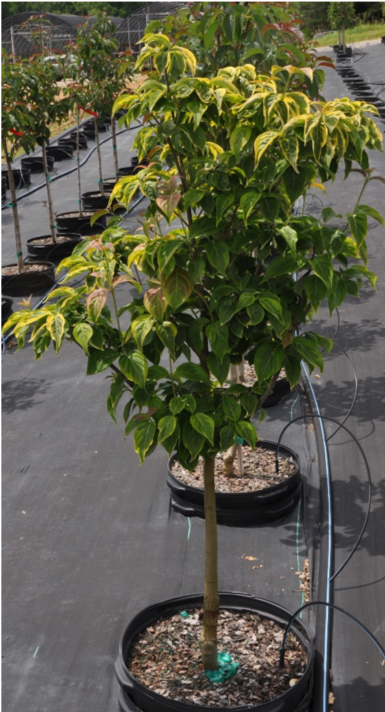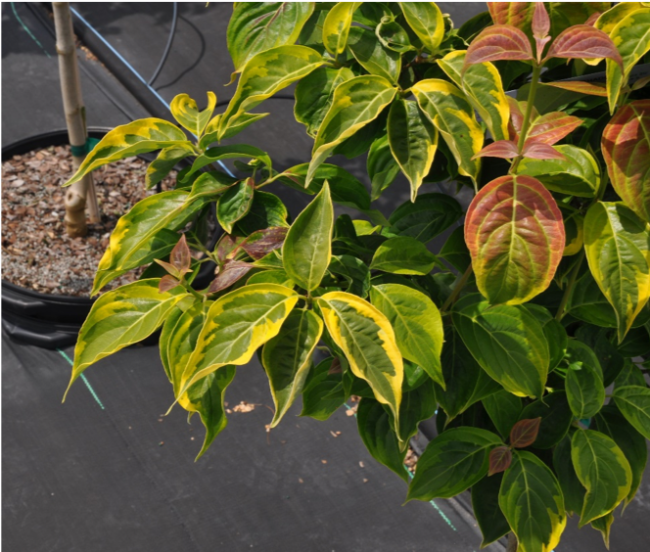- Home >
- 4rconservation
- > Understanding Iron Nutrition in Container Plants
Understanding Iron Nutrition in Container Plants
Iron (Fe) is essential for electron transfer reactions, especially for enzyme systems involved in chlorophyll production. Iron deficiencies first appear on young leaves as a light yellowing (chlorosis). As the leaves expand, chlorosis becomes obviously interveinal while the veins remain green, and resemble a green netting. In severe conditions, Fe-deficient leaves become completely white due to a lack of chlorophyll.
The deficiency symptoms of Fe may initially appear similar to magnesium (Mg) deficiency, because both Fe and Mg are essential for chlorophyll production. However, in most crops, Mg deficiency symptoms initially appear on older leaves while the Fe deficiency symptoms appear on younger leaves.
Iron deficiency in container plants
Iron deficiency symptoms on nursery crops first develop on immature leaves (in between the very young and maturing leaves) as mild chlorosis (light green), due to a lack of chlorophyll. The light color also becomes obvious on the leaf veins close to the stem. As the deficiency continues, the yellow-green chlorosis spreads outwards towards the leaf tips before covering the entire lamina including the veins, petioles and rachis. The chlorotic symptoms then spread to the upper portion of the plant, first appearing on the very young leaves, turning the entire leaf blade chlorotic (yellowish green), and eventually on the growing points.

Young leaf with iron deficiency symptom of
interveinal chlorosis.
The classic Fe deficiency symptom of interveinal chlorosis (veins remain green), is not expressed in all nursery crops. Instead, in some nursery crops the entire lamina (including the veins, ribs and petioles) turn uniformly chlorotic. Eventually, yellowish-green chlorosis gives way to green-yellow color and finally a lemon-yellow color. Cell division and plant growth stops by this point and the plant cannot support plant growth and development.




Images above show four progressive stages (top to bottom) of iron deficiency.
Causes of Fe deficiency
Iron is abundantly present in most soils, and barely present in soilless substrate. Its availability is limited for plant uptake due to poor solubility. Container-grown plants are cultivated in soilless substrates such as peat, pine bark, coir, etc. Iron solubility and plant uptake increases greatly as the substrate pH decreases below 7 (acidic). Factors that favor Fe uptake in plants include low pH acidic root zone environment, good aeration, low alkaline irrigation water, limited availability of free lime, and vigorous root health.

Prolonged waterlogged conditions can induce iron deficiency in plants.
Factors that contribute to Fe deficiency:
1. Excessive substrate liming or pH greater than 7.
2. The presence of calcium carbonate (CaCO3) or free lime in the substrate.
3. Soilless substrate with insignificant concentration of iron source for plant uptake.
4. Irrigation water with high pH or excess alkalinity due to bicarbonate.
5. Soilless substrate with low C:N ratio and insoluble organic matter.
6. Unfavorable weather conditions (excessive rainfall, high humidity and low temperature).
7. Deprived aerobic conditions arising from a high-water table, poor drainage, stagnant water, compaction, or over-watering.
8. Some species including rosaceae taxa require more Fe than others.
9. Some species are sensitive to Fe stress due to the root physiology and precipitation of Fe within the plant cell.
10. High electrical conductivity (EC) or salinity, which result in a poor root system that negatively affects iron uptake.
11. Antagonistic effect of high concentration of micronutrients such as copper (Cu), manganese (Mn) and zinc (Zn) will suppress the uptake of Fe.
12. Low calcium (Ca) and potassium (K) supply will affect root development, which in turn affect Fe uptake.
13. High phosphate supply will react with free Fe, making it unavailable for plant uptake.
14. Low oxygen supply results in poor respiration and poor root development affecting Fe uptake.
15. Container geometry will have direct influence on the water table. Containers of low in height will have a high water table, which subsequently affects root respiration and the formation of iron oxides and hydroxides causing poor Fe uptake.


Dogwood (Cornus) cv. ‘Celestial Shadow’ variegated leaves. This could be misleading for iron deficiency.
Summary
Iron is not highly mobile in plants, so chlorosis begins on young immature leaves and progresses up the plant. Chlorotic symptoms first appear on the leaves as an interveinal light-green color before intensifying finally to a classic interveinal lemon-yellow color as the deficiency worsens. Interveinal chlorosis is observed in most of the nursery species.
The bioavailability of plant nutrient Fe is highest between pH 5.5 and 6.2. This pH level is also the corresponding optimal pH required for growing most container-grown plants. When the pH is above the recommended level, plant growth will be reduced and Fe deficiency symptoms will be more likely to be observed than any other deficiency symptom.
Iron deficiency is a widespread issue that is more prevalent than any other forms of non-biotic stress. The bioavailability of Fe is subject to several factors in the management and operation of crop production mainly due to the chemistry of the element Fe. Therefore, Fe deficiency can be used as an indicator of good versus poor cultural practices in container production system.


